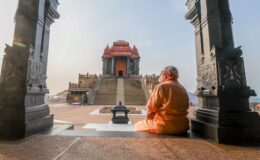For Modi, Service is an article of faith
- By : Anirban Ganguly
- Category : Articles

The general election of 2019 is about six months away. We have reached the last mile, five years of unrelenting action, of undiminished ideation, of indefatigable implementation is completing a full circle. The struggle between the ‘politics of self-alienation’ and the ‘politics of service’ is also intensifying. Subversion, instability, abuse, lies, deceit and false propaganda are some of the instruments in this struggle. Those whose politics stand on self-alienation are taking recourse to these.
The ascent of Narendra Modi has meant the preponderance of the politics of service and of self-discovery; it signified the slowing down of the politics of self-alienation that had hitherto dominated India’s collective political consciousness in the decades following independence. In the last five years Modi has attempted to articulate, structure and draw an Indian grand narrative and he has based his entire effort on the discourse of the politics of service.
The aqueduct of politics of self-alienation has always propped itself up on the pillars of self-repudiation and of negation. The self-repudiation is directed at India’s civilisational dimensions and expressions and accepts external, cultural and political hegemony. The politics of self-alienation is best described by Ram Swarup, one of the pre-eminent political philosophers of post-independent India, as ‘dogmatic and sloganised’, a politics which ‘proclaims its love for the poor’ and yet whose votaries ‘give up no privileges’. It is a politics which uses ‘secular and radical phraseology but is built on contempt of the masses’ and whose secularism is ‘anti-religious in general, and anti-Hindu in particular’.
The politics of self-alienation, argues Swarup, “stirs up regional and communal differences and uses minorities in order to perpetuate a party or dynastic rule, or to set up a dictatorship of one kind or another. It holds common people in low estimation…. It regards them as backward, superstitious, ignorant, illiterate. This view gives rise to its own politics of fraud, force and imposition”. Such a politics negates any effort at creating a grand narrative for India. The politics of the Communist parties and of the Congress—both in the past and the present—exactly fits into the description of the politics of self-alienation.
Modi’s ascent to power in 2014 posed a formidable challenge to this brand and texture of politics, which for decades had burdened and convulsed India. Rahul Gandhi’s Congress continues to resort to it having mastered the politics of fraud and force while other parties such as the Trinamool Congress in West Bengal, at a regional level, have mastered it. The Communist parties in their heydays were adept at peddling it and the Maoists-Naxals and their intellectual drumbeaters continue to perpetuate it.
The Rahul Gandhi-led Congress is leading the charge of the politics of self-alienation. A party of the privileged and led by the privileged with a shrinking base, it has generated social tensions, has worked to erode institutional credibility, has heaped abuse on Modi and has repeated lies ad nauseam to derail our march to self-reliance.
Modi, on the other hand, represents the politics of service. Such a politics, Swarup points out, “requires the capacity to see in common people, even in the midst of their poverty, a new dignity and beauty, new qualities of the mind and the heart”. Such an approach, argues Swarup, “makes us give them due respect and honour; this alone develops in us those qualities of humility, tolerance and understanding, so necessary for any deeper work”. Modi’s governance narrative emphasises on ushering in a ‘new dignity’ for the marginalised.
The mindless call for ‘Modi hatao’ thus is being given by those who thrive on the politics of self-alienation. For Modi politics of service is an article of faith.

















